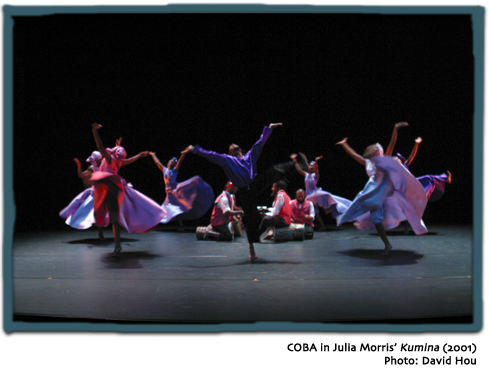BL: Yes, we have live music and it's as important as choreography and dance. We push toward contemporary structure in that we also push our musicians. They have scored two of my works. Again, it's a huge fight because they want to be so very structured and rhythmic. If I say, “Create something for me” and the first thing they give me is something really happy and jolly, I have to say, “No, look at what I'm doing!” It takes them a while.
They actually scored Charmaine's [Charmaine Headley, Bakari's partner and co-director of COBA] last piece and did a great job. They didn't use any traditional drums at all in the scoring of that piece. For COBA, as a company, we have huge Jekyll and Hyde personality switches. We do works that are traditional and structured and very formal with lots of drumming and vibrance and wonderful costuming, and then we do something like Charmaine's work on the same program. Our last program was not as traditional as people would like and, you know, some people were a little t'd off, and said there wasn't enough movement in that piece.
So it's a process of moving an audience and getting them to understand, because they have these embedded notions of Africa being giraffes and elephants walking around, and people in grass skirts cooking wonderful meals all day. Sorry to tell you that some of the longest traffic jams I've had to sit in were in Africa. A trip that would normally take five minutes in Toronto took me three hours – they're very much into the vehicles. The women often dress to the nines; I remember thinking I was in New York at certain moments.
Audience expectation is tied to people's memories of wherever they lived for a number of years, to all they have left behind. They want to see that memory when they come to the theatre – I call them “heritage people”. The pressure of that expectation is always big. It's one of the big burdens – the fact that we have this wonderful vibrance. But on the flip side is the expectation … so whenever we deviate from that the heritage, people are not happy. But we deal with it, we move on and we push them. In the end, audience members said they really liked it – they didn't “get” it – but they liked the direction. Some people said there wasn't enough movement but they enjoyed it, or “we liked the one at the end with the drumming.” And that's fine. People have their preferences and their tastes.
Q: Can you talk about your creative process?
BL: I go with the energy of the room. Some days the energy's really, really high and we are able to dig in right away and get some really big, rich, deep material and other days not much happens. You can tell the dancers want to say: “Tell me what to do and let me do it.”
At least when I'm creating, I'm not big on using the pen and paper for hours, and planning it out. Some works I see as plain as day. When I'm driving I put different pieces of music on and I'm inspired. Ideas come. And other times I simply go in and work from a pure physical base. I'm always challenging myself to move away from habits and norms. I say, this time I want to work really big; or this time I want to investigate working small, or really internal, or expansive. Or whatever the ideas I want to push myself through might be, I go with that and begin to create with those feelings and those impulses in my mind and my body. I'm lucky because I have dancers in the company who have been there thirteen years, so they know. They come in and immediately pick up very quickly and they are able to go with me and understand.
Q: Do you ever use your dancers to create your piece or use improvisation with your dancers to help you to inspire ideas?
BL: We work as a family so they don't feel that if I give something and they want to do something else that they need to be restricted to what I give. In the process they're free and crazy and they do lots of wild things and I say, “No”, or I say, “I like that. Let's go with that idea.” Sometimes they throw ideas in. They hear what I'm doing and they say, “What if we do this?” or “This would be really cool.” So yes, to answer your question, it goes back and forth.
Q: I was just wondering, because of your background and varied training – has there ever been a time when you thought of yourself as being less traditional, or thought less of your Western influences – or have you always embraced your “embodied body”.
BL: I don't think about it. When I first began to work with Danny Grossman, I felt that I really needed to separate the two streams. But I realized very early that I could actually bring them together. What I realized, innately, was that a lot of Danny's work was “low” and I could use my traditional experience, all the low work that I do in traditional dance, to help me. The other dancers would hate me because I was never sore after Danny's rehearsals since I was used to my physicality of being low all the time from traditional work.

Q: I know you talked about some of the traditions and contemporary forms. I'm wondering if there's a particular Western dance company or dancer who has really influenced you?
BL: I'm very open to many movement styles. I have made choices, and I have physical preferences for things that feel good. As a dancer, I love Graham. I was fortunate in my training to study while Martha Graham was alive, and had the experience of her standing at the back of the room while I was taking class. I had what I call the good, hardcore experience of Graham, and it's a technique I love. I like the grit and the earthiness of it.
I love Horton too. Most of my early modern dance training was in Horton and it got me strong very fast. I'm open. I'm very open. Dance is about excitement, and if I sit in the audience and my spine is tingling then I'm there. It doesn't have to be a particular style. If I go to a performance and sit there and say “Wow!” then style doesn't matter. Chinese, South Asian, contemporary dance, ballet, many styles have done that to me. In performance, I think it's about the dancer and the richness and honesty they throw out to you, and not about movement. I tell people Karen Kain was great not because of how well she executed steps but because she's a beautiful woman, very genuine and honest. It's not about how well you do steps. It does not matter how high you jump if, when you are up there onstage, you cannot really reach out and touch an audience. It's about what you say with movement, and what you're speaking about.
CA: Thank you BaKari!

home l shop dcd l history l links l donations l the collection l services l shipping policy l CIDD l exhibitions l CDFTP
educational resources l visits & lectures l making archival donations l grassroots archiving strategy l personnel l RWB alumni



